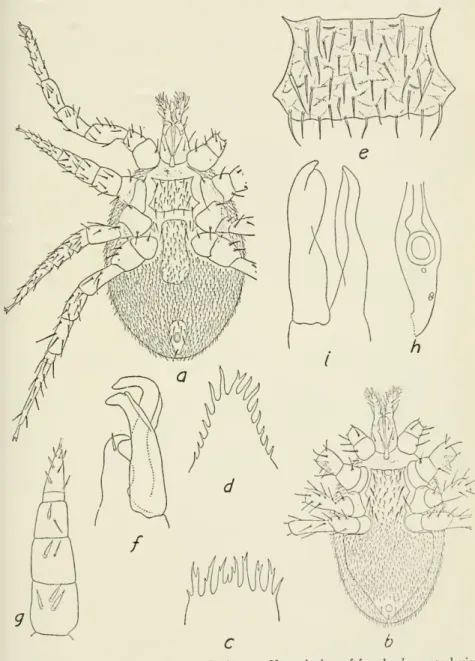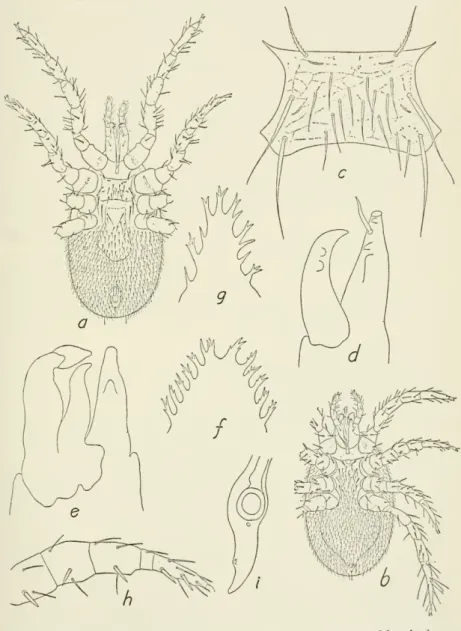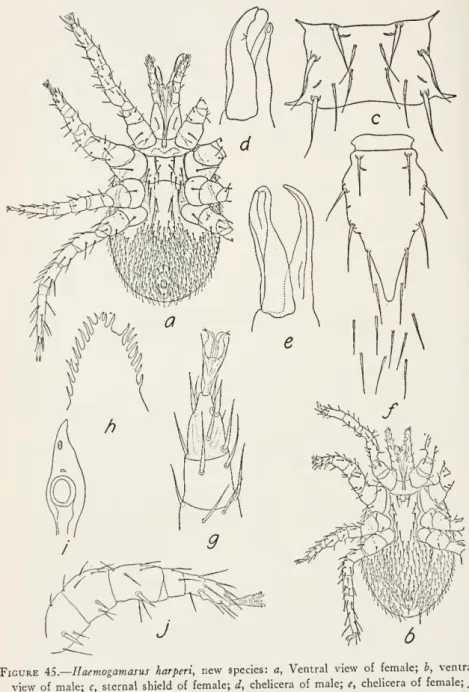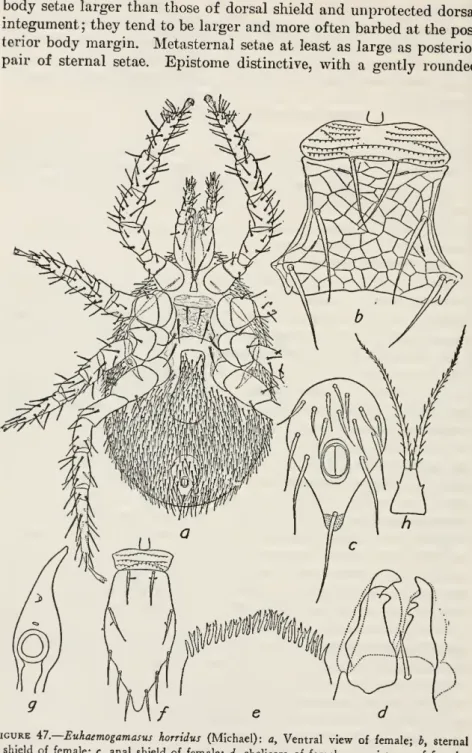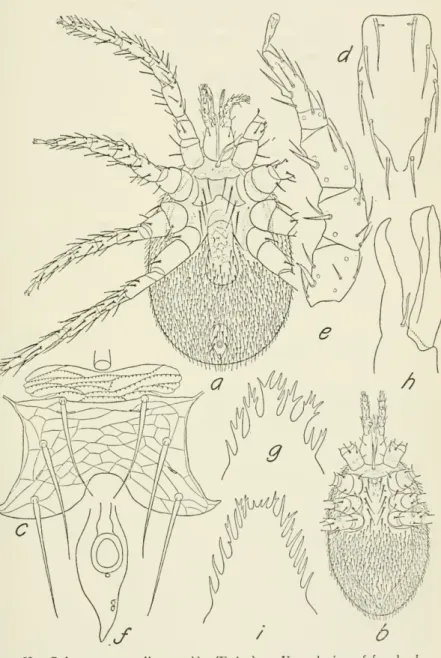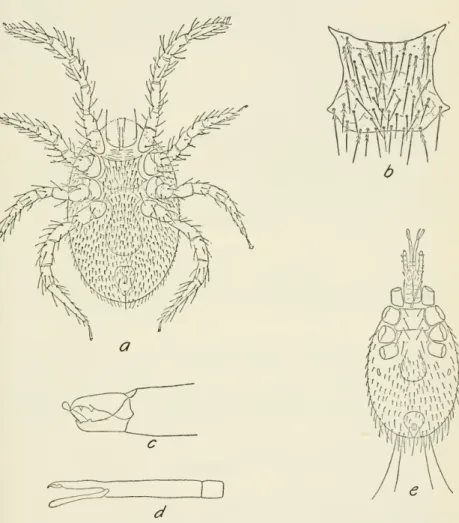Accessory setae variable in size and larger near anterior and posterior margin of carapace. Setae on the back, expanded part of the carapace larger than that of the carapace and, like them, of two.
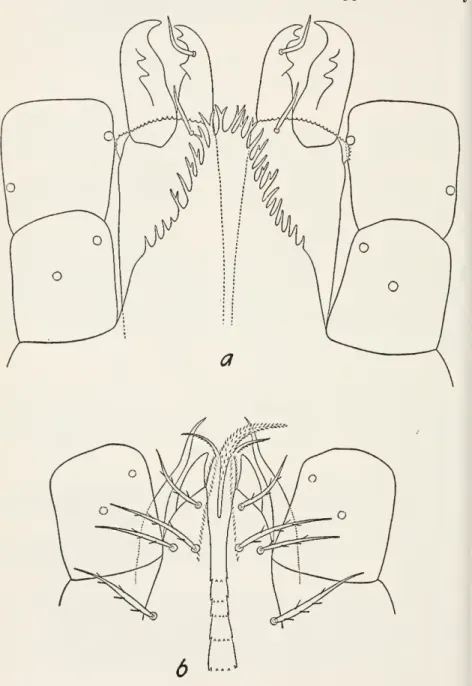
MITES OF SUBFAMILY HAEMOGAMASINAE — KEEGAN 213
214 PROCEEDINGS OF THE NATIONAL MUSEUM
MITE'S OF SUBFAMILY HAEMOGAMASINAE — KEEGAN 215
Maxillae as in female, except that lateral horns are more blunt; as in the female, the anterior pair of maxillary setae are smooth. As in adults, the anterior pair of usual sternal setae are barbed and are thicker than the others.
MITE'S OF SUBFAMILY HAEMOGAMASINAE — KEEGAN 217
218 PROCEEDINGS OF THE NATIONAL MUSEUM
MITES OF SUBFAMILY HAEMOGAMASINAE — KEEGAN 219
Genitoventral shield with 55 or 60 accessory setae, in addition to pair of larger genitoventral setae; accessory setae about twice as long as dorsal shield setae; a definite gap between the usual genitoventral setae and most anterior accessory setae; Common genitoventral setae and most accessory setae smooth; some near posterolateral margin with spines. MYTHS OF THE SUBFAMILY HAEMOGAMASINAE - KEEGAN 221 prominence on anterior margin of anal shield; rear end of.
MITES OF SUBFAMILY HAEMOGAMASINAE — KEEGAN 221 prominences on anterior margin of anal shield; posterior end of
Distinguishing features of this mite are: Mostsetae on the dorsa and ventral surfaces with barbs; a large number of accessories on the sternum present over the entire shield; two pairs of accessories on the front edge of the breast shield; six or seven anal hairs; solid chela with split point, two teeth and a seta; movable chela with two teeth; most. Due to the unusually short description and lack of numbers, it is difficult to determine the relationship between this mite and others in the genus.
MITE'S OF SUBF'AMILY HAEMOGAMASINAE — KEEGAN 223 HAEMOGAMASUS HARPERI, new species
224 PROCEEDINGS OF THE NATIONAL MUSEUM VOL. 101
MITE'S OF SUBFAMILY HAEMOGAMASINAE — KEEGAN 225
Male: Citation as in female; narrow ventral shield, not covering entire ventral surface or curving anteriorly laterally to coxae IV; second pair of ordinary sternal setae on lateral margins of shield; accessory sternal setae absent; long, narrow anal area; femur, genu, tibia and tarsus of leg, each with a conspicuous strong ventral seta; that of tarsus II about halfway between the anterior and posterior ends of tarsus. Nymph: Citation as in adult; ventral shield tapering more gradually backwards than in other species; anal shield with six setae; accessory setae larger than ordinary setae; mouthparts as in female; short, abrupt tapering tarsia in adults.
MITES OF SUBFAMILY HAEMOGAMASINAE — ^KEEGAN 227
HAEMOGAMASUS KITANOI ASANUMA
Setae sparser in apical region, but over rest of carapace between 9/and 12jliapartlaterally and 9jLi to 20/x apart anteroposteriorly. They average about 35/1 in length, but may be larger in the apical region and at the posterior margin. Dorsal body setae larger and not as closely spaced as setae on carapace, nearly all barbed, larger adposterior body margin.
Accessory setae numbered 70-85 in all European specimens examined; usual pair of genitoventral setae anterior to all accessory setae and larger than the latter; more anterior accessory setae larger.
MITES OF SUBFAMILY HAEMOGAMASINAE — KEEGAN 229
Spiny setae present on all palpal segments except tarsus; ventral setae stout on coxae barbed. Additional setae larger and not as numerous as those of dorsal shield; much more numerous in some specimens than in others. Maxillae and palpi as in female, except for the sexual dimorphism shown in leg II, where the ventral extensions are as follows: femur two, genu one, tibia one, tarsus two.
Carapace much narrower than in adults; setae not as numerous as in adults; mostare smooth; dorsal pores not visible; aslite-like invagination of each lateral margin of carapace at level of coaxial IV. Anal shield with three usual anal setae and one smaller accessory seta in most specimens; a few possess a second accessoiy seta near the anterior margin of the carapace. When Michael (1892) published his description of Haemogamasusnidi, this was therefore accepted as the original description of the species.
Type specimens of the following North American species also share most of these features: HaemogamasiiS.
MITES OF SUBFAMILY HAEMOGAMASINAE — KEEGAN 233
234 PROCEEDINGS OF THE NATIONAL MUSEUM
She. - Set of back shield approx. 15;u, separated and of nearly uniform size, varying between 40/x and 60/* in length; usual apical setae clearly the largest setae on the carapace. Setae of apical region, slightly larger than others; all setae on carapace smooth; five pairs of poreson shields. Setae of unprotected dorsal integument larger than those of carapace, especially at lateral and posterior body margins, where some may have barbs; three or four terminal pairs distinctly larger than other terminal setae.
Sternal shield strongly sculptured; slightly longer than wide, with an early straight posterior margin; all sternal setae large, stout and smooth; anterior flank middle third of anterior margin of carapace. Anterior pair of sternal pores posterior and slightly lateral to bases of anterior pair of sternal setae; a few anterior sutures of carapace with tiny spines; front and rear pair of seta approximately equidistant from middle pair. Genitoventral shield strongly sculptured; with anearl}^ straight posterior margin in some specimens; usual pair of genoventral setae smooth and smaller than sternal and metasternal setae; accessory teae less,.
236 PROCEEDINGS OF THE NATIONAL MUSEUM VOL. 101
MITE'S OF SUBFAMILY HAEMOGAMASINAE — KEEGAN 237
238 PROCEEDINGS OF THE NATIONAL MUSEUM
MITE'S OF SUBFAMILY HAEMOGAMASINAE — KEEGAN 239
Female.—Dorsal shield widest at level of coxae II, not covering entire dorsal surface; with six pairs of pores. Setae of shield relatively sparse, 30/x to 60ju, apart and about 45)li long; only ordinary pair of barbed apical setae. Base of each seta of unprotected dorsal integument with a spine-like posterior extension; these setae slightly larger than those on the shield; a few at lateral and posterior body margins with spines.
Genitoventral shield relatively large and widely expanded posteriortocoxaeIV; extending more than two-thirds of distance between coxae IV and anal shield; possess usual genitoventral setae and 10 to 20 accessory setae in a number of 14 specimens examined; mean was 15; all accessory setae are posteriortousual genitoventral setae and are smaller than the latter;.
MITES OF SUBFAMILY HAEMOGAMASINAE— KEEGAN 241
242 PROCEEDINGS OF THE NATIONAL MUSEUM
MITE'S OF SUBFAMILY HAEMOGAMASINAE — KEEGAN 243 widely expanded posterior to coxae IV and curved anteriorly lateral
The specimens examined were found in a variety of habitats: in straw, flax rope, rice straw, rice husks, in turf and in association with the wax moth. In the United States it has only been taken three times: once from a nest of Tamiasciurus fremonti bee. About Tigridiabulbs, Netherlands, intercepted during quarantine in Philadelphia, Pennsylvania, May 13, 1946; wheat straw jacket, France or Germany, in Cleveland, Ohio, August 10, 1945; in turf, Scotland, in New York, August.
MITES OF SUBFAMILY HAEMOGAMASINAE — KEEGAN 245
Abdominal shield not covering entire ventral surface; expanded posteriorly to lateral margins of coxae IV; gradually tapering to a point in the anal region; bearing sternal, metasternal, usual and accessory geni-ventral setae and usual and accessory anal setae. Relative size and placement of legs as females; femur, genu, tibia, and tarsus of leg II each have a conspicuously heavy ventral portion with a thick proximal and slender distal portion. Usual genitoventral setae flank posterior side of carapace; setaeas in adults in relative size and position, except that middle pair of sternal setae are on lateral margins of carapace.
MITE'S OF SUBFAMILY HAEMOGAMASINAE — KEEGAN 247
Distribution and Hosts.—This species has been taken from several eastern and southern United States and southern Canada.
MITE'S OF SUBFAMILY HAEMOGAMASINAE — KEEGAN 249
250 PROCEEDINGS OF THE NATIONAL MUSEUM
MITES OF SUBFAMILY HAEMOGAMASINAE — KEEGAN 251 accessory setae, over 100 in all specimens examined, is distinctive, these
Male: arrangement of dorsal and ventral surfaces as in females; ventral shield widely extended posterior tocoxae IV and curved anteriorly lateral tocoxae IV; anal. Ewing (1925) described E.harberias that differed from microti in having the outline of the epistome oval in barheri and not in microti, and the marginal teeth of the epistome large and branched in microti and small and simple in barberi. Results from examination of type material and specimens from a variety of hosts in Maryland indicate that these species are synonymous and that barben is the valid specific name based on page priority.
Almost all groups of all animals have spines, but some on the dorsal shield may be smooth. The setae of the dorsal body are largest at the posterior end of the body, where four of them are extraordinary in length, being nearly half the length of the body of the mite. Sternal shield rectangular, with an almost straight posterior margin; no indication is given whether the sternal setae are spiny or smooth.
The legs are not shown, but Vitzthum reports that the only smooth setae on them are those on tarsus I and on the distal ends of other tarsi.
254 PROCEEDINGS OF THE NATIONAL MUSEUM
MITES OF SUBFAMILY HAEMOGAMASINAE — KEEGAN 255 EUHAEMOGAMASUS LIPONYSSOIDES OCCIDENTALIS, new subspecies
Anal shield with only the three usual anal hairs and three most anterior accessory hairs; carapace may be narrower than in the nymph of lipondyssoides; anterior edge of carapace rounded. Distinguishing features of this subspecies that serve to distinguish females, males, and nymphs from those of liponyssoides are: Female: Usual pair of apical setae of the dorsal shield, few if any larger than other setae in the apical region; large and small bristles distributed on the dorsal shields; barbed lacinae of tritosternum; spines on presternal sutures unclear; posterior margin of breast shield almost straight; genitoventral shield with 28 to 35 accessory setae; anterior margin of anal shield almost straight; almost all fimbriae of epistome distal in position and a total of no more than 10 or 12 fixed chela with both a distal seta and a proximal seta.
MITES OF SUBFAMILY HAEMOGAMASINAE — KEEGAN 257
Sternal shield with accessory setae; at least leg II conspicuously stout and with spurs and massive, often blunt, setae especially on tarsus; anal shield of male separate; accessory set a representative ventral shield of nymph. Doi*sal shield relatively short, with a blunt, slightly indented posterior margin; much of dorsal surface unprotected. Setae of unprotected dorsal integument smooth and those on the back of the body longer and more slender than those on the shield.
Sternal shield not clearly defined, its lateral and posterior edges somewhat irregular; Common sternal setae smooth and larger than accessory setae, which are numbered. 28, 27, and 23 specimens available for study and are scattered over the shield in no apparent pattern; these are of various sizes, but are largest near the borders of the shield; none present at anterior end of shield; all are smooth. Anterior pair of sternal pores nearly parallel to anterior margin of shield; lateral margin of posterior pair of pores in contact with lateral margins of shield; carved shield.
Genitoventral shield relatively narrow, about three and a half times as long as wide and with nearly parallel lateral margins and an irregularly rounded, nearly truncate posterior margin; possess a regular pair of genitoventral setae and several nearly equally sized accessory setae; these number 6, 7 and 8 in the three women examined.
MITE'S OF SUBFAMILY HAEMOGAMASINAE — KEEGAN 259
Male. Body shape, carapace, bristles with exposed dorsal surface, tritosternum and presternum area as in females. It is narrower posterior to coxae IV and tapers to a bluntly rounded end immediately anterior to the anal shield; The arrangement of the ventral surface differs from that of females, as they do not have an accessory set on the central part of the carapace, nor do they have an accessory set. Paratypes. - A male on slide with type, one female, two nymphs, Dos Palmos, California, of Perognathus spinatus., March 1934, H.
Most dorsal shield hairs are 20/* to 40/i apart and about 40/* long; those in the central part may be closer together; most setaeon carapace is almost as large as the usual apicaletae; some. Breastplate rectangular, with rounded corners and a slightly incised posterior margin; in addition to the three pairs of usual bristles, there are several large accessory bristles, which varied in variation. Bases of usual embossed bristles; breast pores relatively long and curved; centrally located accessory bristles that are slightly smaller than the more laterally located bristles.
Genitoventral shield spherical posteriorly and not reduced in size; only the seta on the anterior half of the carapace consists of a usual pair of genitoventral setae; accessory setae are smaller and.
262 PROCEEDINGS OF THE NATIONAL MUSEUM
MITES OF SUBFAMILY HAEMOGAMASINAE — KEEGAN 263
MITES OF SUBFAMILY HAEMOGAMASINAE — KEEGAN 265
KEY TO NYMPHS OF HAEMOGAMASINAE
KEY TO MALES OF HAEMOGAMASINAE
MITE'S OF SUBFAMILY HAEMOGAMASINAE — KEEGAN 267
LITERATURE CITED
